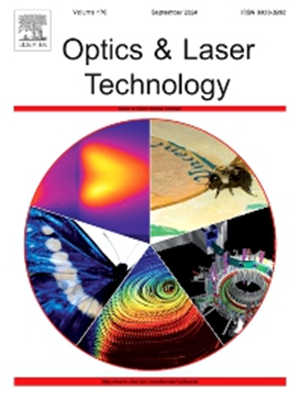Supercontinuum generation in singlemode fibers using dissipative soliton resonance pulses at 1560 nm
IF 4.6
2区 物理与天体物理
Q1 OPTICS
引用次数: 0
Abstract
In this article we explore the possibility of utilizing 1560 nm nanosecond dissipative soliton resonance pulses for generation of supercontinuum radiation in a standard singlemode fiber. The source is based on a non-complex, all-in-fiber dissipative soliton resonance mode-locked laser and two sections of fiber amplifiers, boosting the peak power and pulse energy to 147 W and 0.42 µJ, respectively. Pulses with a repetition rate and pulse duration of ∼1.01048 MHz and 2.67 ns, respectively, were injected into a standard singlemode fiber (SMF-28, Corning) with lengths between 100 m and 600 m. Induced Stimulated Raman Scattering effect resulted in a broadening of the pulse spectrum from the initial 1560 nm, up to ∼2100 nm. Our results are the first demonstration of using high-energy nanosecond pulses from a non-complex, all-in-fiber dissipative soliton resonance mode-locked laser in a frequency conversion process in a standard singlemode fiber. The proposed approach delivers an alternative solution to broadband light generation using complex nanosecond laser sources.
利用 1560 纳米波长的耗散孤子共振脉冲在单模光纤中产生超连续介质
本文探讨了利用 1560 nm 纳秒耗散孤子共振脉冲在标准单模光纤中产生超连续辐射的可能性。该光源基于非复杂的全光纤耗散孤子共振锁模激光器和两段光纤放大器,可将峰值功率和脉冲能量分别提高到 147 W 和 0.42 µJ。将重复率和脉冲持续时间分别为 1.01048 MHz 和 2.67 ns 的脉冲注入长度介于 100 m 和 600 m 之间的标准单模光纤(SMF-28,康宁公司)。诱导受激拉曼散射效应使脉冲光谱从最初的 1560 nm 扩展到 2100 nm。我们的研究结果首次证明,在标准单模光纤的频率转换过程中,可以使用来自非复合全光纤耗散孤子共振模式锁定激光器的高能纳秒脉冲。所提出的方法为使用复杂纳秒激光源产生宽带光提供了另一种解决方案。
本文章由计算机程序翻译,如有差异,请以英文原文为准。
求助全文
约1分钟内获得全文
求助全文
来源期刊
CiteScore
8.50
自引率
10.00%
发文量
1060
审稿时长
3.4 months
期刊介绍:
Optics & Laser Technology aims to provide a vehicle for the publication of a broad range of high quality research and review papers in those fields of scientific and engineering research appertaining to the development and application of the technology of optics and lasers. Papers describing original work in these areas are submitted to rigorous refereeing prior to acceptance for publication.
The scope of Optics & Laser Technology encompasses, but is not restricted to, the following areas:
•development in all types of lasers
•developments in optoelectronic devices and photonics
•developments in new photonics and optical concepts
•developments in conventional optics, optical instruments and components
•techniques of optical metrology, including interferometry and optical fibre sensors
•LIDAR and other non-contact optical measurement techniques, including optical methods in heat and fluid flow
•applications of lasers to materials processing, optical NDT display (including holography) and optical communication
•research and development in the field of laser safety including studies of hazards resulting from the applications of lasers (laser safety, hazards of laser fume)
•developments in optical computing and optical information processing
•developments in new optical materials
•developments in new optical characterization methods and techniques
•developments in quantum optics
•developments in light assisted micro and nanofabrication methods and techniques
•developments in nanophotonics and biophotonics
•developments in imaging processing and systems

 求助内容:
求助内容: 应助结果提醒方式:
应助结果提醒方式:


